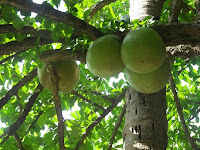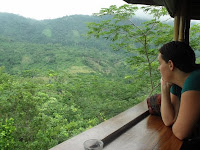Finally finishing it ...Read the North Ghana section first!
The Village
In the North, the crops are grown during the three-month rainy season (June-August) to sustain the communities for the next year. Irrigation has not been developed. Kirsten (A peace-corp friend I visited) says in Burkina Faso, just 30 minutes away, everyone irrigates, and produce is provided year-round. Burkina Faso is the third economically poorest country in the world, but it's doing more with less.
Right: Ghanaian Maize, T-Zed is the main starch made from it. Unlike banku, and kenkey, t-zed is not fermented. If you've been to Zimbabwe, it's a lot like sadza.
Right: T-Zed (white ball) in bito stew with goat meat.
Bito is a common dark leafy green in the north, and goat meat is extremely popular. I found it quite tasty!
Boreholes are the main source of water for the village. As this village sprawls for miles and miles, there are quite a few. Women and girls pump the water into buckets, put it on their heads, and walk home.
Laundry is done close to the borehole and dried on a nearby tree to save time.
Lucky, Ghanaian village women live near boreholes designed to be filled with buckets on their heads. Definitely saves back strain! Boreholes look like public showers, and your friend has to pump the water while you standstill. None were in this village.
Kirsten, my Peace-Corp friend, helped develop a tree nursery. The family in the photo to the right takes care of the trees. The nursery has a huge wall to protect the trees from all the donkeys, cattle, goats, chickens, and guinea fowl. Trees are attached to the family's house. The mother, standing next to Kirsten, is one of the most joyous Ghanaians you will ever meet! She only speaks FraFra but happiness radiates from her.
Right: Family who guards the trees.
The Market
To enter the Bolga Market you have to walk through the bus station. Traders pedal their wares. The man to left was one of the most colorful traders. He allowed me to take his picture on the condition I remembered the story of his name. I cannot spell it but I guess it is Dwange. He said it is the traditional act that is used to ensure a woman will keep her baby. A sheep is sacrificed, and the blood is treated by a traditional healer and drunk by the mother.
Left: Dwange, trader and barer of an important traditional name.
Bush products for sale. I wonder if they were poached illegally from Mole National Park? Hmm.... I didn't ask any questions.
On the other hand, bushmeat is very popular in Ghana, as hunting, apparently, still exists as a profession.
Right: you can see the horns, and in the boxes are porcupine quills, smaller horns, and bones of various animals. Hunting is a traditional profession, culturally accepted if not internationally approved.
These skins hung to the right of the stand above. The skin to the right looks like a civet and the one to the left is a cheetah, again didn't ask questions so I could be wrong!
Left: Skins at the market.
Tire shoes!!! We always hear how the rest of the world lives on what America throws away. Here is a fun example #1: the rubber of car tires made into shoes.
Fun example #2: Recycled clothes. In Ghana, used western clothing is sold everywhere. Very few people buy new Western clothes. Many actually look new. It is a shock to sometimes see a University of Michigan worn by a pedestrian. The weirdest part for me was an American Indian Medicine Wheel on a 'Walk to Prevent Diabetes' shirt! (I intern with an American Indian health and community center in Detroit).
Northern tunics are made and sold at the very back of the market. The market is huge! Winding through small roads created by all the stands/tables/open shops it takes about 10 minutes (if your not stopping!) to get to the back.
In the bottom right corner are the bolts of woven cloth. At these tunic stands, tailors sow the cloths together into one big fabric and then turn them into a tunic. The hanging tunic is for a man. The women's tunic is like a long dress. It looks and feels very heavy, but everyone swears its light enough to wear in summer!
The End
Special
Thank You! to Kirsten and JayJay for hosting me that weekend.
Here's a story to make you smile. I woke up Saturday morning to the sound of this very happy couple giggling. They've been together 7 years, married 5 years, and just about spent the past 2 years in this small village & still, they wake up in the morning and laugh over breakfast. love it!
Bye-Bye Northern Ghana!
Left: Me with my Bolga basket!
Note: If you're traveling, buy the
double weave baskets instead of the single weave, allowing for the double bend! (see the handle of the second basket peeping over the brim?)
 Right: One type of typical Accra House, shared by a large family.
Right: One type of typical Accra House, shared by a large family.















































